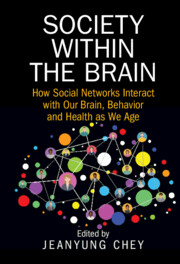Book contents
- Society within the Brain
- Society within the Brain
- Copyright page
- Dedication
- Contents
- Figures
- Tables
- Contributors
- Preface
- Introduction
- Part I Approaches to Society within the Brain
- Part II Society Interacting with Brain, Cognition, and Health in Late Life
- Chapter 5 The Life Course Approach to Cognitive Aging and Dementia
- Chapter 6 Enriched Social Connectedness and Brain Function
- Chapter 7 Psychoneuroimmunology Linking Social Isolation with Cognitive Aging
- Chapter 8 Loneliness and Psychological Health in Late Life
- Part III An Individual’s Cognitive Aging with Others: Key Findings, Issues, and Implications
- Index
- References
Chapter 8 - Loneliness and Psychological Health in Late Life
from Part II - Society Interacting with Brain, Cognition, and Health in Late Life
Published online by Cambridge University Press: 28 September 2023
- Society within the Brain
- Society within the Brain
- Copyright page
- Dedication
- Contents
- Figures
- Tables
- Contributors
- Preface
- Introduction
- Part I Approaches to Society within the Brain
- Part II Society Interacting with Brain, Cognition, and Health in Late Life
- Chapter 5 The Life Course Approach to Cognitive Aging and Dementia
- Chapter 6 Enriched Social Connectedness and Brain Function
- Chapter 7 Psychoneuroimmunology Linking Social Isolation with Cognitive Aging
- Chapter 8 Loneliness and Psychological Health in Late Life
- Part III An Individual’s Cognitive Aging with Others: Key Findings, Issues, and Implications
- Index
- References
Summary
While social disconnection has been consistently perceived as a threat to human beings, objective and subjective social disconnectedness have been associated with poor physical well-being and a higher mortality rate. These factors are equivalent to or more significant than other well-known risk factors, such as smoking. Although mild to severe loneliness persists across the lifespan, correlates of loneliness show age differences, and loneliness affects late-life depression and accelerates the rate of physiological decline with age. In many societies, older adults undergo a transition in social life after retirement or bereavement, leading in many cases to social isolation, which may result in loneliness. This chapter reviews the effects of social isolation on late-life psychological health, focusing on the role of perceived isolation, also known as loneliness. It also discusses multiple risk factors contributing to loneliness, which can be described in terms of trait and state loneliness. Lastly, it notes that not all social connections are beneficial for all when discussing gender differences in social networks.
Keywords
- Type
- Chapter
- Information
- Society within the BrainHow Social Networks Interact with Our Brain, Behavior and Health as We Age, pp. 175 - 192Publisher: Cambridge University PressPrint publication year: 2023



